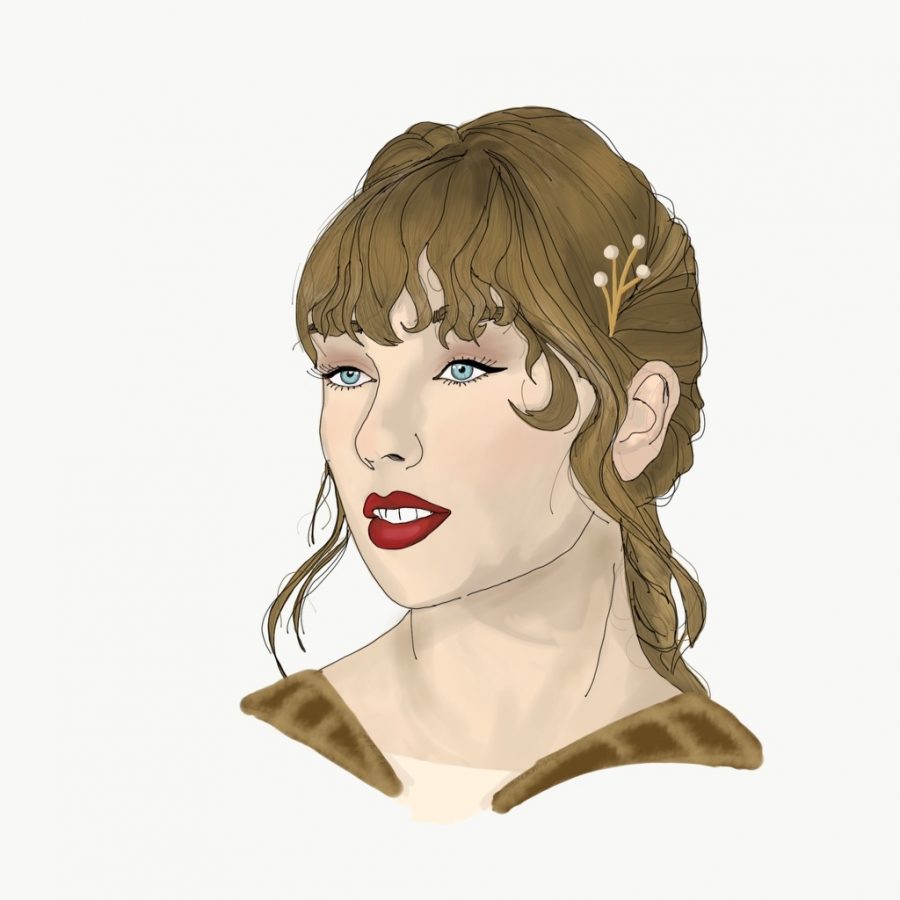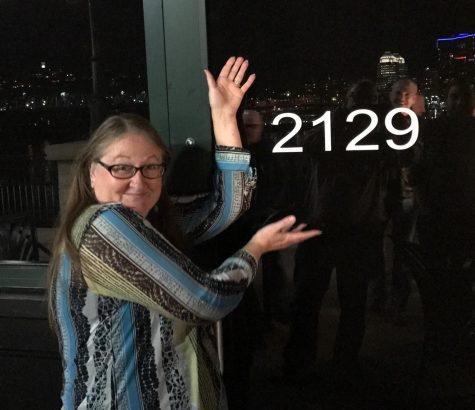Long story short: “evermore” is the perfect continuation of the “folklore” era
Taylor Swift: a three-syllable name that everyone in the world has heard of at least once in their lifetime. Known for chart-topping albums such as “1989” and “Reputation,” Swift is easily recognizable in the music industry as both a talented singer and songwriter. However, the stigma that surrounds Taylor Swift and her “pop-y, breakup songs” now ceases to exist in her newest album, “evermore.” For years, Swift has been judged and crudely misinterpreted by the media because of her “infamous” love life that would spark inspiration for her future songs. Many would criticize fans for liking Swift and her music, simply because of this strongly misjudged persona that the media has painted upon Swift. However, Swift has decided to move past this caricature by diving into the “folklore/evermore” era.
“folklore” was released on July 24 of 2020, as a complete surprise to the general public. Swift announced the unexpected album on Instagram with nine posts that consisted of a layout of the black and white album cover, as well as a final post that described Swift’s thoughts during the time.
“In isolation my imagination has run wild and this album is the result, a collection of songs and stories that flowed like a stream of consciousness. Picking up a pen was my way of escaping into fantasy, history, and memory,” Swift wrote. “I’ve told these stories to the best of my ability with all the love, wonder, and whimsy they deserve. Now it’s up to you to pass them down. folklore is out now.”
The “folklore” album, Swift’s transition into alternative/folk-pop, included an intricate and exquisite storyline that also flowed into “evermore.” This storyline included the infamous plot that Swift fans call the “betty/james/august” plotline; a story from the people who lived in her Rhode Island home before her. Throughout “folklore,” Swift tells a story of two high school sweethearts— a girl named Betty and a boy named James. However, James consistently cheats on Betty during the summer with the unnamed “august” girl (in order, as told by songs “august,” “mirrorball,” “betty,” “cardigan,” “illicit affairs,” “exile,” and, “the 1”). In an attempt to win Betty back, he explains in “betty” that it was a mistake and he still loves her (“The only thing I wanna do is make it up to you,” and, “If you kiss me, will it be just like I dreamed it? / Will it patch your broken wings? / I’m only seventeen, I don’t know anything, but I know I miss you”), but Betty recognizes her self-worth and moves on from James. Though James desperately tries to get Betty back after high school, he realizes the only way to move on is to leave town, and so he joins the army (keep in mind, this is set in the mid-1900s). James ends up dying in battle, and after his funeral, Betty goes crazy, unable to process that James is gone. She then escapes to Rhode Island, and at this time, Taylor Swift is born in Pennsylvania (“seven”), and essentially grows up. Betty passes away, and Swift then buys Betty’s Rhode Island home (“the last great american dynasty”). This plotline, though not quite essential, is interesting to think about when listening to “folklore,” and its sister album (“evermore”).
However, the “folklore” era did not give fans much time to process the 16 song tracklist with its intricate plot, along with the bonus track, (“the lakes”) and the Disney+ exclusive documentary entitled “folklore: the long pond studio sessions,.” Not even five months later, Swift surprised fans yet again with a follow-up, sister album to “folklore,” named “evermore.” Released on Swift’s 31st birthday, “evermore” is, to say the least, a beautiful album. The ballads of “dorothea” and “gold rush” mixed in with hints of debut era Taylor Swift like, “no body, no crime” and “cowboy like me” show Swift’s transition as a former pop artist, now sophisticated, alternative-esque songwriter.
It is hard to review a Taylor Swift album without discussing the titular track, especially considering the notable lack of one in her latest album. “evermore” is the last song on the tracklist and is Swift’s second ballad with folk band Bon Iver’s frontman, Justin Vernon. Written by both of the aforementioned pair along with Swift’s longtime boyfriend, Joe Alwyn, the song opens with the beginnings of Swift and Alwyn’s relationship and her subsequent social media downfall, before moving on to chronicle the struggles of quarantine and isolation. Relying heavily on the soft piano music to communicate the melancholy feeling of the song, Swift sings about losing herself in a situation with no foreseeable end (“Hey December/Guess I’m feeling unmoored/ Can’t remember/What I used to fight for”), as Vernon responds with lyrics about wanting to return to a time before (“To be certain, we’ll be tall again”). However, despite the initial feeling of hopelessness, the song follows a narrative, and in the final verse, the perspective changes. Despite the persisting lyrics, “I was catching my breath,” and “catching my death,” she no longer believes in permanence and sees an end. This is where Swift’s relationship comes back into play, as it becomes apparent that the love interest is saving her as she sings, “And when I was shipwrecked / I thought of you.” Other than from an analytical standpoint, the song is ethereal, and probably one of the best on the album. Swift’s soft vocals contrast nicely against Vernon’s when the tempo picks up, and the overlapping of the two singer’s voices conveys the dual perspective of “exile” very successfully. “evermore’s” position as this album’s most important song is well deserved, and is something worth highly noting for people who do not want to listen to the entire album.
The song “happiness” was not even supposed to be on “evermore”, and was written and recorded a mere week before its release. With its rare lack of romantic entanglement, “happiness” takes on a new perspective for the album. Instead, the song is more about Swift’s relationship with herself and how she has changed and evolved through the years, each album and era being different from her last. As the chorus slowly trickles in, “There’ll be happiness after you / But there was happiness because of you too,” Swift regales how each version of herself is not really the end, there is more growth and learning past it, but this does not take away from the experience that it gives her. She may be evolving, but that which she has done is still important. This “you” to which Swift refers could to some be seen as her partner, but lyrics in the other verses negate this to herself. The line “And in the disbelief, I can’t face reinvention /I haven’t met the new me yet” alludes to the fact that her most recent albums are sister albums, and since they are the same era of her music, she has not changed, or “met the new her.” This narrative continues with the line, “Sorry, I can’t see facts through all of my fury /You haven’t met the new me yet.” The song also includes several references to Swift’s previous label, Big Machine Records (she also chooses to reference the label in her song “Closure,” which is heavily rumored to be about her struggle with BME to gain control of her own music), with digs regarding their split after her seventh album, and how the “smile became a smirk” (how they no longer had her best interests at heart). Despite how rushed its production was, “happiness” is beautifully quotable, and fits right into the wistful new direction she is taking her music, without getting lost in the mix. It may be a smaller sounding, bittersweet song, but it clearly holds its own against the album’s more melodramatic tales.
“cowboy like me,” tells the fictional love story of two con-artists feeling remorse while scamming rich people symbolizes the return of country Taylor Swift. It is a compelling tale from a lyrical standpoint, but is unfortunately the weakest track on the album. Saying that this song is the weakest is not to say it is a bad song, but is unable to hold a candle to the growth that Swift has achieved in the rest of her new album. “no body, no crime,” the other song on “evermore” which has a more country feel to it, successfully integrates itself into the flow of the album. However, “cowboy like me” just falls short comparatively. The song would feel more at home in an earlier album, such as her second album “Fearless,” or even possibly “Speak Now,” especially with it being thematically more of a classic love song, which Swift seemed to move away from with “evermore.” If the song were to be reproduced, however, it could be an easy favorite with its artfully crafted lyrics: “Now you hang from my lips / Like the Gardens of Babylon / With your boots beneath my bed / Forever is the sweetest con.” This problem of misused and overproduced musical arrangement is also a slight problem on “folklore” with “the last great american dynasty” not being given sufficient room to breathe. In that instance though, it stopped a great song from being phenomenal whereas is “evermore,” it stops a good song from being great. Though it has relatively more shortcomings than the rest of the tracklist, “cowboy like me” is a good song nonetheless, and its inclusion is still very much appreciated.
The sixth track of the album, “no body, no crime” reminisces back to 2006, first album Taylor Swift as acoustics of guitar, piano, and mandolin are featured in the background. The song has a very detailed and intense plot, which makes it even more of a lyrical masterpiece. Taken from Taylor Swift’s perspective, Swift sings about her fictional friend, Esté, who is losing sleep due to worry that her husband is cheating on her (“Her husband’s actin’ different, and it smells like infidelity”). Esté claims, “That ain’t my Merlot on his mouth, that ain’t my jewelry on our joint account / No, there ain’t no doubt, I think I’m gonna call him out.” This then leads to the chorus of a repetitive, “I think he did it, but I just can’t prove it,” which is essentially Esté calling out her husband for cheating on another woman, but lacks the evidence. The plot then thickens when Esté goes missing— she isn’t “seen at her job at Olive Garden, at her house, or anywhere.” Swift then goes on to believe that her husband has killed her after finding out he cheated, as she sings, “And I noticed when I passed his house, his truck has got some brand new tires / And his mistress moved in, sleeps in Esté’s bed and everything.” The chorus then repeats again, except this time the meaning is Swift believing Esté’s husband is the cause of Esté’s murder, but again, she has no proof. As if this plot couldn’t get any thicker, the bridge of “no body, no crime” consists of Swift being extremely suspicious, saying, “Good thing my daddy made me get a boating license when I was fifteen, and I’ve cleaned enough houses to know how to cover up a scene / Good thing Este’s sister’s gonna swear she was with me (She was with me, dude) / Good thing his mistress took out a big life insurance policy.” This gives the listener reason to believe that Swift killed Esté’s husband, because he killed Esté. The chorus then switches to, “They think she did it, but they just can’t prove it / She thinks I did it, but she just can’t prove it.” Everyone believes it was the mistress who killed Esté- it’s the most obvious choice, she was the reason they broke up— but the mistress just knows it was Taylor, but yet again, she can’t prove it. The immaculate plot that is “no body, no crime,” as well as the hidden links and metaphors, gives reason for this song to be one of the best songs on the album.
This song also sparked interest among Harry Styles fans, as both Styles’ and Swift’s fans alike researched and interpreted both artists’ songs, resulting in the infamous theory— that Harry Styles and Taylor Swift committed vehicular manslaughter in New York and hid the body. Just before “evermore” was released, fans were already speculating about this viral theory, but as the tracklist went public, Swift simply added fuel to the fire with “no body, no crime.” Though it seems impossible, and well, criminal, to assume this, let me, Casey Shoultz, Sports Editor and Harry Styles Enthusiast, break it down. Mostly speculated from Swift’s songs, as Styles had been in One Direction as well as on a temporary hiatus from releasing music during the time in question, Taylor Swift and Harry Styles went to New York (hence Swift’s song, “Welcome to New York”) for reasons unknown around 2012-2013. The two accidentally kill someone there, Swift’s entire “1989” album giving me reason to believe it is due to Harry Styles’ deplorable driving (given Swift’s “Out of the Woods” bridge– “Remember when you hit the brakes too soon? / Twenty stitches in a hospital room / When you started crying, baby, I did too / But when the sun came up, I was looking at you”), and soon hide from their mistakes (“I Know Places,” again from “1989”). Of course, there are more minor details, such as the two running away from authorities (“Getaway Car” and “Sign of the Times,” both interpreted as parallels). Then the story continues with the coping mechanisms and aftereffects that come with vehicular manslaughter— Swift and Styles leaving New York as well as each other, hoping to never see one another again in hopes of forgetting their incident, Swift having a temporary haven of peace (“I Forgot That You Existed”) before realizing she cannot cope alone— but also cannot tell anyone what she did, and Styles then reenters her life as not a lover, but a mutual friend (“It’s Nice To Have A Friend,” “the 1”). The “folklore” era is more so Styles and Swift reflecting on their past and moving on together, ending frets and accepting what has happened. There are also more minor details that could not fit within such a simple paragraph, but one can listen to the different songs not listed on a Spotify playlist! However, noting that this is just a theory, there is no actual proof that this happened, but as it was a viral speculation on social media, it felt fitting to include.
Presumably one of the best songs on the entire album— if not the top track of Swift’s ninth album— “champagne problems,” in all its pianist glory, takes on the subject of mental health and unfortunate endings with lovers. Essentially, the song narrates the story of a woman who shocks her would-be fiancé, as well as everyone around her, by turning down their marriage proposal (“Because I dropped your hand while dancing, left you out there standing / Crestfallen on the landing / Champagne problems”) because of mental health issues. The word spreads around about the failed proposal, and the town’s gossip appears to stigmatize and blame the narrator’s mental health as the reason (“No crowd of friends applauded / Your hometown skeptics called it champagne problems”). Looking upon the meaning of the song and lyrics, it seems that the repeating words of “champagne problems” hold a meaning of all of the protagonist’s mental health issues; assuming that this is true, that is why the woman keeps repeating herself after every verse (which also coincidentally describes every wronging in her life). Throughout the song, the protagonist tells the story of the failed marriage, as well as her perspective on the situation. The narrator doesn’t exactly know why she said no (“And I couldn’t give a reason / Champagne problems”); instead, repeatedly blaming it on the so-called “champagne problems.” Though the woman seems apologetic and sorry for her ex-lover, it seems as if it is better for her mental health (along with her possible fear of commitment) to not push herself into a marriage (“I never was ready so I watch you go”) where she might be confined to such a relationship. Towards the ultimately iconic bridge of the song, the narrator is reflecting on her past love, as well as trying to move on from the situation, but is afraid of whether her life will ever be the same again. The bridge sings the beautifully written lyrics of “November flush and your flannel cure,” touches on how the woman deals with her mental health by coping with humor, singing, “This dorm was once a madhouse” / I made a joke, “Well, it’s made for me,” how scared she is that her friends will leave her because of the failed proposal (“How evergreen, our group of friends / Don’t think we’ll say that word again”), how the town is gossiping about her (“She would’ve made such a lovely bride, What a shame she’s fucked in the head,” they said), and how the woman resolved the situation by presumably telling her ex-lover that he’ll find someone who will treat him better than she ever did (“But you’ll find the real thing instead / She’ll patch up your tapestry that I shred / And hold your hand while dancing / Never leave you standing / Crestfallen on the landing / With champagne problems”), someone who will make him forget all of her champagne problems.
The thirteenth track, and one of the most beautiful songs on the album, “marjorie” is a tribute to Taylor Swift’s late grandmother. Appropriately, this song is also a parallel to “folklore’s” “epiphany,” which was about Swift’s grandfather, Dean. Marjorie Finlay, who unfortunately passed in 2003, is heard in the background vocals of this exquisite eulogy, which makes the song even more meaningful. The song includes advice (“Never be so kind, You forget to be clever / Never be so clever, You forget to be kind,” and, “Never be so politе, you forget your power / Nevеr wield such power, You forget to be polite”) that Swift’s grandmother presumably said to her, and essentially is Swift reminiscing about the times she had with her grandmother. Though Marjorie has passed, she still lives on in Swift’s heart, as Swift sings, “What died didn’t stay dead / You’re alive, you’re alive in my head.” The bridge of “marjorie” tells stories of the times the two shared together, such as swimming (“Long limbs and frozen swims / You’d always go past where our feet could touch”), as Swift wishes she didn’t take the moments for granted and instead savored the moment. The emotional lyrics of, “I should’ve asked you questions / I should’ve asked you how to be / Asked you to write it down for me / Should’ve kept every grocery store receipt / ‘Cause every scrap of you would be taken from me,” represent Swift’s emotions during this time, and how much her grandmother meant to her. Swift repeatedly sings, “And if I didn’t know better I’d think you were singing to me now / If I didn’t know better, I’d think you were still around,” throughout the song, but towards the ending of “marjorie,” Swift switches the lyrics with, “I know better, But I still feel you all around / I know better, But you’re still around,” showing how she understands and accepts her grandmother has passed, but her spirit still lives on for evermore.
“folklore” and “evermore:” an unexpected but all the most accepted era of Taylor Swift, signals a new beginning for the talented singer and songwriter. No longer just a pop star who writes about her breakups, Swift is moving on for the better to a new sound. “folklore,” with its intricate plotline, and “evermore,” with its invisible string attached to “folklore” create a beautiful story that truly is Taylor Swift. With new deluxe songs released on the “evermore” deluxe version, Swift rerecording her older music, and a potential new album coming soon, a new, exciting time is coming for Swift and her fans. But for anyone who didn’t want to read two mega fans write excitedly about Taylor Swift and her plotlines and just skipped to the conclusion, long story short: “evermore” is the perfect continuation of the “folklore” era.
Our Very Questionable and Compromised* Evermore Ranking
(An Attempt at Objectiveness)
*Casey likes “no body, no crime” too much, Sequoia thoroughly enjoys “evermore”
“champagne problems”
“gold rush”
“marjorie”
“happiness”
“long story short”
“no body, no crime”
“evermore”
“dorothea”
“tis the damn season”
“ivy”
“coney island”
“willow”
“closure”
“tolerate it”
“cowboy like me”
“gold rush-” ”gold rush” is the tale of a girl in love with someone who is admired by everyone and a relationship that could never be, despite persistent daydreaming about what could be. By the end of the tale it is accepted that their story is impossible, despite how fantastical it may appear.
“long story short-” “long story short” is essentially the surmised summarized version of Swift’s feud with Kanye West, and its subsequent tarnishing of her image, including their personal fallout. This narrative was additionally a big major part of her “Reputation” album, but in “long story short” there is resolution and the drama has passed, with the words “long story short / I survived.”
“dorothea-” ”dorothea” tells the story of a girl, Dorothea, who leaves her hometown to pursue her dreams in Hollywood. However, the song is not told from her perspective, but that of her old lover who now only watches her from home on his screen. He supports her and hopes for success, but still waits for her return should she ever decide to come home.
“tis the damn season-” “tis the damn season” is a continuation of the “dorothea” storyline with the girl who left to chase fame coming back for the holidays, where she reminisces on what could have been if she stayed. She appears to regret her decision as she realizes that her lover is the only one who truly sees her anymore, and all paths now lead back to him.
“ivy-” “ivy” follows a married woman falling in love with someone else, as she begins an affair, wondering why he wants her when he will never be able to truly have her. Despite the impossibility of everything, she fights for moments with him, and despite the risk of her husband finding out, she won’t stop because she is in love [“You Are In Love”].
“willow-” “willow” is the only song on the album to have an accompanying music video, and it recounts Swift’s relationship with her boyfriends, as she was interested in him despite her current situation, “I’m begging for you to take my hand / Wreck my plans, that’s my man.” The willow comparison alludes to the fact that despite the tumultuous look of their relationship, they are stable and not going anywhere.
“coney island-” “coney island” is more of an ode to a broken relationship than a love song. Their relationship is failing as Swift loses herself in it, wondering how they lost it all and got there. The duet with The National’s Matt Berninger touches on lovers not giving each other enough before abandoning each other, with the only thing left to do is look back at the good times.
“closure-” “closure” is the aftermath of Swift’s split with label Big Machine Records (specifically a public argument with Scooter Braun). They ended on bad terms, and yet, the label is still reaching out to try and “fix things,” and end on amicable terms. Swift, however, is past it. From her perspective, she no longer needs the fake words and their validation; she wants to move on. The new chapter of both of their lives has begun, and Swift does not want nor need them to be intertwined any longer.
“tolerate it-” “tolerate it” is a struggle for a woman desperately trying to keep the love alive with a man that is indifferent about her affections. She is giving it her all and getting nothing in return, hopelessly waiting for recognition. This plotline is based on a book that Swift read, called Rebecca, by Daphne de Maurier
Hello there! Our goal is to provide relavent, engaging journalism for readers of all ages. Your donation will support the student journalists of the Wolfpacket at Claremont High School, and will allow us to purchase equipment, print our monthly issues, and enter in journalism competitions. We appreciate your consideration!

Sequoia Clark is a senior at CHS, and the head Editor-In-Chief for the Wolfpacket. She enjoys writing unnecessarily long articles about Taylor Swift, and...

If you have explored Instagram in the vast few months, there is only one person that has continuously posted updates from their favorite musical artists...








